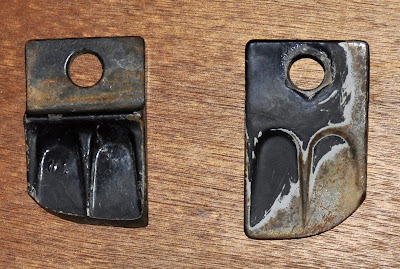Since we purchased our tractor I've been able to rapidly increase the pace of my post hole augering to the point that I hope to have most of the perminant fencing done by the fall of this year. The auger is increadibly fast and can dig most holes in under two minutes. However, with the increase in speed comes an increase in required maintenance. After augering about 30 holes through a dense mixture of clay, sand, and rocks, I noticed that the replaceable bit tips attached to the end of the auger had become considerably worn down. After reordering replacements from John Deere at a cost of approximately $50, I decided to try hardfacing as a future cost saving strategy.
Until recently I had assumed that hardfacing was really only something you could do with a stick welder. Most books I could find only describe hardfacing with a stick welder and some even say it's not possible with the average MIG welder. However, last month while I was exploring the McMaster-Carr website I saw a 1 pound reel of flux core 0.035" MIG hardfacing wire listed for $31.26. I figured it looked like a promising solution, so I ordered a reel.
The product arrived in the mail with only the instructions you see in the photo above, so I was a little unsure how it would work out.
Since there was no guidance for machine settings, I used the machine's recommended settings for normal flux-cored wires. Generally I found the wire to be more brittle than normal wire while loading in the machine and had a few jams in the machine that cost me several yards of wire each time it occurred. Much of this was probably my fault though, as I had forgetten the importance of setting the right amount of tension in the feed roller. Too much pressure can flatten the flux-cored wire (leading to jams) and too little can lead to wire slippage. The resulting welds are not very aesthetically pleasing and I did have occasional issues with bubbles forming in the welds. I have yet to test the quality of the welds, but when I do I will update this post.
Update:
I haven't tested the hardfacing yet, but I did figure out the probable cause of the bubbles appearing in my initial welds. It appears that I had the voltage set too high on the welder because when I turned down the speed and voltage the bubbles went away. The picture below shows the second set of hardfaced and repainted welding bits. Some of the welds, especially the weld on the fishtail bit (left) may have been a little too cool when made, so I still have yet to find a happy medium.
Update:
So after running a test comparison between the wear rate on the a brand new auger bit from John Deere and a rebuilt hardfaced bit, I found that they tended to wear at the same rate. While I'll continue to look for better solutions in the future, I've found that, for now, rebuilding parts with the H12 tool steel MIG hardfacing wire is significantly less costly than purchasing new bits.
With that In mind I've now started hardfacing other earth-handling equipment, such as the bucket tooth in the above photograph.





